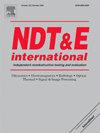MTR-MUSIC: A time-reversal based super-resolution ultrasonic imaging method for multilayer structure defects
IF 4.5
2区 材料科学
Q1 MATERIALS SCIENCE, CHARACTERIZATION & TESTING
引用次数: 0
Abstract
Closely spaced defects, like porosity and microcracks, are common during material manufacturing and service. Due to the limitations of array aperture and ultrasonic frequency, traditional ultrasonic imaging methods cannot characterize defects under the Rayleigh limit. The time-reversal multiple signal classification (TR-MUSIC) method is effective for subwavelength defect imaging. However, TR-MUSIC is only suitable for isotropic medium, not including multilayer mediums. Furthermore, the axial localization ability of TR-MUSIC is influenced by severe axial extended artifacts. To deal with the above limitations, a modified time-reversal multiple signal classification (MTR-MUSIC) method is proposed. An improved Green's function is developed to correct the travel time errors caused by acoustic refraction in multilayer mediums, and the total focusing imaging index is utilized as a weighted factor to mitigate the axial artifacts associated with TR-MUSIC. Experiments are conducted on 2 mm spaced side-drilled holes in multilayer structure specimens. The results show that MTR-MUSIC can accurately image two holes with a distance of 0.43 Rayleigh limit in triple-layer mediums, and the full width at half maximum of the axial main lobe is below 1 mm, which shows better axial localization ability. It demonstrates promise for MTR-MUSIC in super-resolution imaging defects among anisotropic mediums, including immersion detection, weld structures, and composite materials.

MTR-MUSIC:一种基于时间反转的多层结构缺陷超分辨超声成像方法
紧密间隔的缺陷,如孔隙和微裂纹,在材料制造和使用过程中很常见。由于阵列孔径和超声频率的限制,传统的超声成像方法无法表征瑞利极限下的缺陷。时间反转多信号分类(TR-MUSIC)方法是一种有效的亚波长缺陷成像方法。但TR-MUSIC仅适用于各向同性介质,不包括多层介质。此外,TR-MUSIC的轴向定位能力受到严重的轴向扩展伪影的影响。针对上述局限性,提出了一种改进的时逆多信号分类方法(MTR-MUSIC)。开发了改进的格林函数来校正多层介质中声折射引起的走时误差,并利用总聚焦成像指数作为加权因子来减轻与TR-MUSIC相关的轴向伪影。对多层结构试件进行了间距为2mm的侧钻孔试验。结果表明:在三层介质中,MTR-MUSIC可以精确成像距离为0.43瑞利极限的两个孔,轴向主瓣半最大值处全宽小于1 mm,具有较好的轴向定位能力;它展示了MTR-MUSIC在各向异性介质中超分辨率成像缺陷的前景,包括浸没检测、焊接结构和复合材料。
本文章由计算机程序翻译,如有差异,请以英文原文为准。
求助全文
约1分钟内获得全文
求助全文
来源期刊

Ndt & E International
工程技术-材料科学:表征与测试
CiteScore
7.20
自引率
9.50%
发文量
121
审稿时长
55 days
期刊介绍:
NDT&E international publishes peer-reviewed results of original research and development in all categories of the fields of nondestructive testing and evaluation including ultrasonics, electromagnetics, radiography, optical and thermal methods. In addition to traditional NDE topics, the emerging technology area of inspection of civil structures and materials is also emphasized. The journal publishes original papers on research and development of new inspection techniques and methods, as well as on novel and innovative applications of established methods. Papers on NDE sensors and their applications both for inspection and process control, as well as papers describing novel NDE systems for structural health monitoring and their performance in industrial settings are also considered. Other regular features include international news, new equipment and a calendar of forthcoming worldwide meetings. This journal is listed in Current Contents.
 求助内容:
求助内容: 应助结果提醒方式:
应助结果提醒方式:


